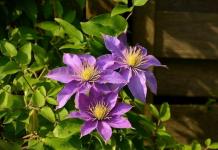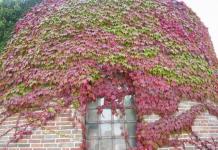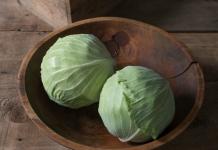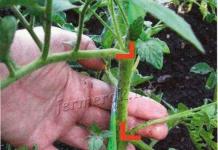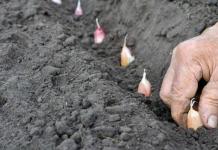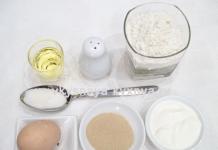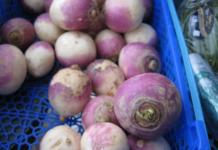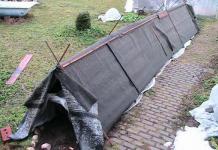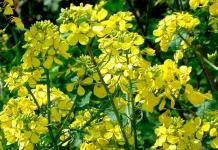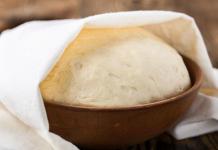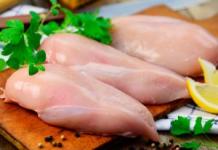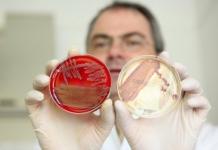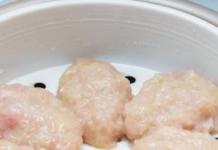The goal of all gardeners is a rich fruit harvest. However, to grow it, you need to constantly take care of fruit trees, to be engaged in the prevention and treatment of diseases. And the dangers that lie in wait for trees are many. Several ailments can affect the pear. After reading this article, you will learn about the most common diseases of the pear, about the methods of their prevention and treatment.
Have you ever noticed dark brown or black lesions on the foliage, branches and trunks of your trees? These are signs of an infectious disease called bacterial burn. It often affects fruit plants. The bacteria Erwinia amylovora provoke the disease, they are spread by insects, wind, rain.
Did you know? Cases of fire blight have been documented as far back as the 18th century. And now, for two and a half centuries, this disease has caused great inconvenience to gardeners all over the world.
A pear bacterial burn is very dangerous. It is able to spread at lightning speed to healthy trees and even lead to the most sad consequences - the final death of the garden. Therefore, it is necessary to start fighting the burn at the initial stage.

Treatment. If a disease is detected at the initial stage, the affected branches should be removed, the cut should be processed with a 1% solution of copper sulfate (100 g per 10 L of water) or a 0.7% solution of ferrous sulfate (70 g per 10 water). Treatment with 5% Azophos solution is also effective, antibiotics: chloramphenicol, rifampicin, streptomycin, gentamicin, nalidixic acid and kanamycin at a dosage of 1-2 tablets / ampoules per 5 liters of water (enough for 8-10 trees). Trees are best cultivated in May-June. When inflorescences appear and during flowering, treatment with 1% Bordeaux liquid can also be effective. In case of significant damage, diseased pears and trees located at a distance of 5 m are recommended to be uprooted and burned.
Important! Such types of pears as Likashovka, Conference, Favorite, Bere Gardi most often fall ill with a bacterial burn. Moskovskaya, Yanvarskaya and Muratovskaya pears proved to be the most persistent.
 The first signs of damage to your trees by brown spot can be observed in late spring - early summer. The leaves are covered with brown spots. Their number is rapidly increasing every day, and soon the entire leaf turns brown and then falls off. Massively pears become infected in July-August. Treatment. If this disease is detected in trees, the fallen leaves should be carefully removed. Since this is a fungal disease, treatment must be carried out with antifungal agents - fungicides with copper in the composition. In this case, please note that spraying must be stopped immediately after the start of fruit growth.
The first signs of damage to your trees by brown spot can be observed in late spring - early summer. The leaves are covered with brown spots. Their number is rapidly increasing every day, and soon the entire leaf turns brown and then falls off. Massively pears become infected in July-August. Treatment. If this disease is detected in trees, the fallen leaves should be carefully removed. Since this is a fungal disease, treatment must be carried out with antifungal agents - fungicides with copper in the composition. In this case, please note that spraying must be stopped immediately after the start of fruit growth.
Important! Bere, Kure, Ardanion, Klappa are resistant to brown spotting.
Pears often develop a disease called scab. The causative agent of scab - the fungus Fusicladium pirinum - affects fruits, leaves, shoots. The main symptoms of the disease are: olive-colored spots with a velvety bloom on the underside of the leaf, leaf fall, fruit cracking and hardening of their pulp. On the fruits, dark lesions with a light rim and a brown bloom become noticeable. The pear becomes covered with cracks, the fruit is deformed, takes on an irregular, asymmetrical shape.
 Treatment. If the scab affects young shoots, then the only way to deal with the sore is to remove them. It is recommended to treat with 1% Bordeaux mixture, copper oxychloride in three stages: the first - in the period of bud appearance; the second - immediately after flowering; the third - 15 days after the second.
Treatment. If the scab affects young shoots, then the only way to deal with the sore is to remove them. It is recommended to treat with 1% Bordeaux mixture, copper oxychloride in three stages: the first - in the period of bud appearance; the second - immediately after flowering; the third - 15 days after the second.
Important! Muratovskaya, Rusanovskaya, January pears are resistant to scab.
Fruit rot (moniliosis)
If your attention is drawn to the brown spots on the pears, then the mushroom Monilia fructigena, which causes the fruit rot or moniliosis of pears, has most likely made its way into your garden. The disease develops rapidly - within a week the fetus can become completely brown. Later, white growths can be observed on the fruits. The pulp becomes loose and tasteless. Sick pears fall off, some can dry out and remain on the branches for up to two years. If the disease is not treated in time, then it will provoke growths on the branches of the pear. The spread of rot is observed from mid-July to August, especially during hot and humid summers.  Treatment. Diseased fruits and branches must be destroyed. Branching should be done both in spring and autumn. It is recommended to sprinkle pears with fungicides and strengthen their immunity using root dressing from a bio-cocktail (Aktofit, Ekoberin, Zdorovy Sad, Baikal).
Treatment. Diseased fruits and branches must be destroyed. Branching should be done both in spring and autumn. It is recommended to sprinkle pears with fungicides and strengthen their immunity using root dressing from a bio-cocktail (Aktofit, Ekoberin, Zdorovy Sad, Baikal).
Important! High immunity to moniliosis in Cheremshina pears, Autumn Dream, Honey. Fully resistant species to fruit rot have not yet been bred.
Mosaic disease
Mosaic disease is most dangerous for pears. The characteristic symptoms are angular light yellow or pale green spots on young leaves. You can infect a tree with a virus during grafting.
Treatment. Unfortunately, this disease cannot be treated. It is no longer possible to help seedlings and trees. They need to be burned so that the virus does not spread to the trees growing nearby.
Sooty fungus is a type of leaf and shoot disease in which a black, soot-like bloom covers the foliage.  Treatment. Spraying trees with a copper-soap solution (5 g of copper sulfate and 150 g of soap per 10 liters of water), a solution of Bordeaux liquid or copper oxychloride. Only one pear variety is completely protected from soot fungus - Cathedral.
Treatment. Spraying trees with a copper-soap solution (5 g of copper sulfate and 150 g of soap per 10 liters of water), a solution of Bordeaux liquid or copper oxychloride. Only one pear variety is completely protected from soot fungus - Cathedral.
Important! Moskvichka, Dukhmyanaya and Yanvarskaya pears are famous for their persistent immunity to powdery mildew.
Rust
Rust can affect all varieties of pears.
Root cancer occurs in young plants. It is caused by the bacterium Agrobacterium tumefaciens. On the roots and root collar of seedlings, hard woody growths of various sizes are formed. In the case of diseased seedlings, the bacteria-causative agents of root cancer can live in the soil for several years.  Treatment. Before planting seedlings, they must be carefully diagnosed and infected with root cancer must be removed. Small growths on the lateral roots must be cut off, the roots must be disinfected for 5 minutes in a 1% solution of copper sulfate.
Treatment. Before planting seedlings, they must be carefully diagnosed and infected with root cancer must be removed. Small growths on the lateral roots must be cut off, the roots must be disinfected for 5 minutes in a 1% solution of copper sulfate.
Important!Most stableto the root cancergrade - Lemon.
 Black cancer affects the bark of the trunk, skeletal branches and fruits. First, small cracks or wounds form on the bark, which further increase, which provokes breaks in the bark. Bright brown spots appear around the wounds.
Black cancer affects the bark of the trunk, skeletal branches and fruits. First, small cracks or wounds form on the bark, which further increase, which provokes breaks in the bark. Bright brown spots appear around the wounds.
Treatment. To prevent the appearance of pear cancer, fallen leaves are carefully removed and burned. Infected fruits and areas of the bark are removed, fresh wounds are smeared with copper sulfate, clay with mullein, or special lubricants. They inhibit the development of black crayfish and fungicides.
Important! High immunity to "Antonov's fire" is observed in pear varieties Avgustovskaya dew and Samaryanka.
The cause of cytosporosis of the pear can be frost cracks and sunburn. With cytosporosis, the pear bark turns red-brown and dries up. On the diseased areas, tubercles are formed - an accumulation of the causative agent of the disease: the fungus Cytospora leucostoma.  Treatment. The recipe for the treatment of pear cytosporosis is identical with the methods for treating black cancer. Owners of Moskvichka and Yanvarskaya pear should not be afraid of this disease.
Treatment. The recipe for the treatment of pear cytosporosis is identical with the methods for treating black cancer. Owners of Moskvichka and Yanvarskaya pear should not be afraid of this disease.
Cracks in the bark
Are there cracks in the bark of your pear? There can be many reasons for this - these are sudden changes in temperature (frost cracks, sunburn), and too deep planting of trees in the soil, and unsuccessful pruning, and excessive and untimely application of fertilizers.


